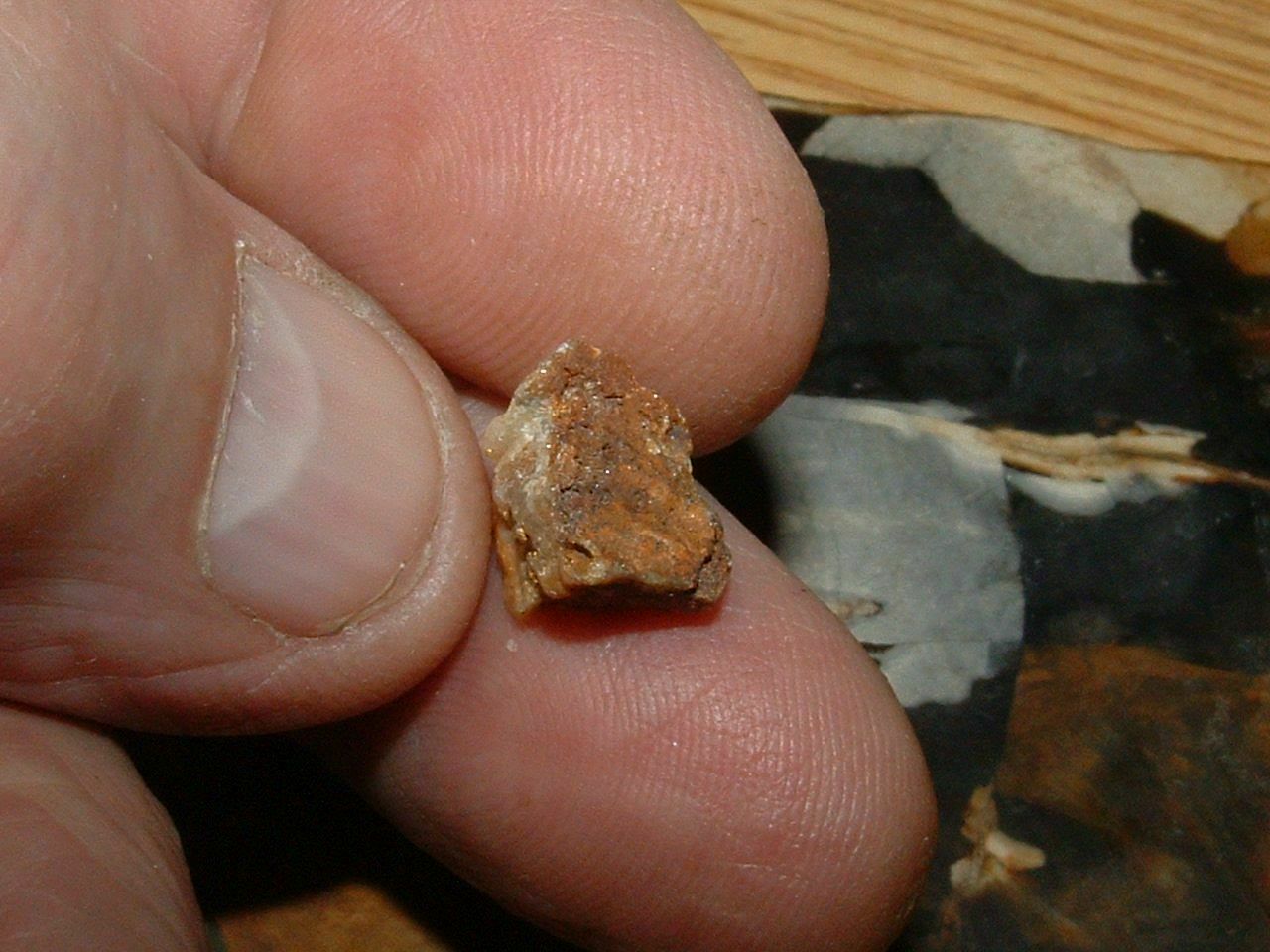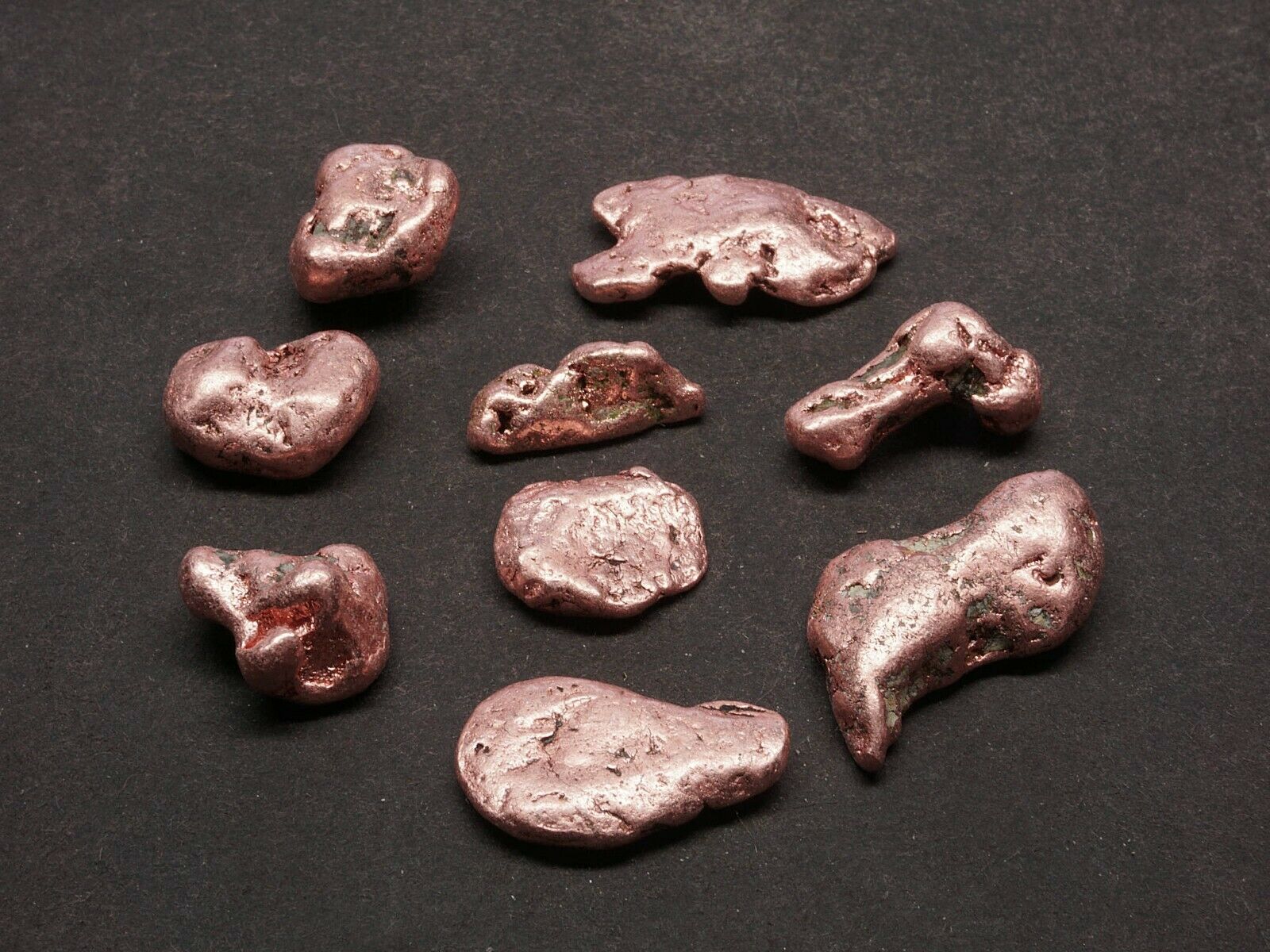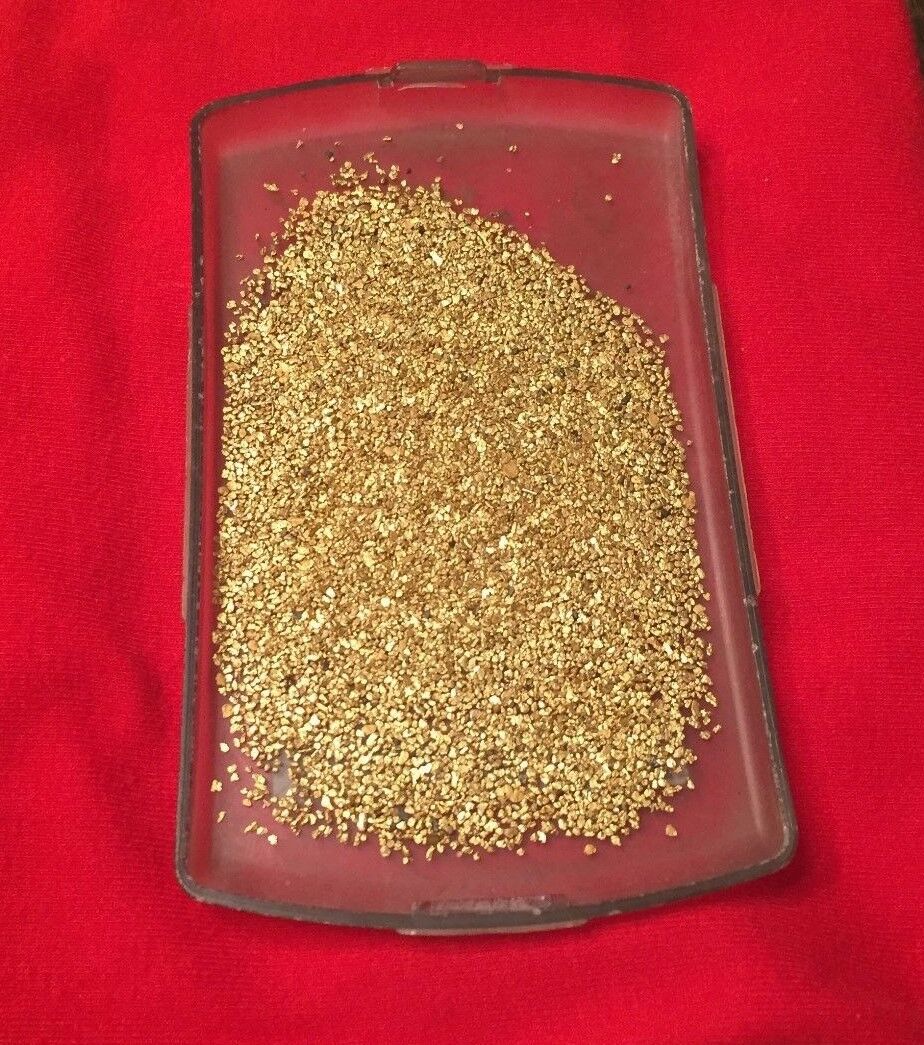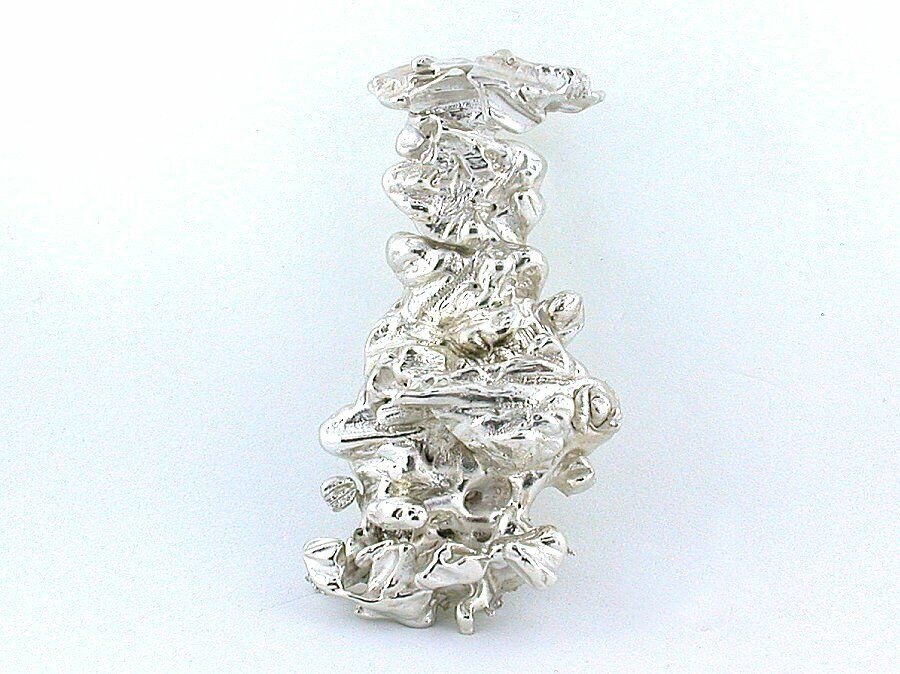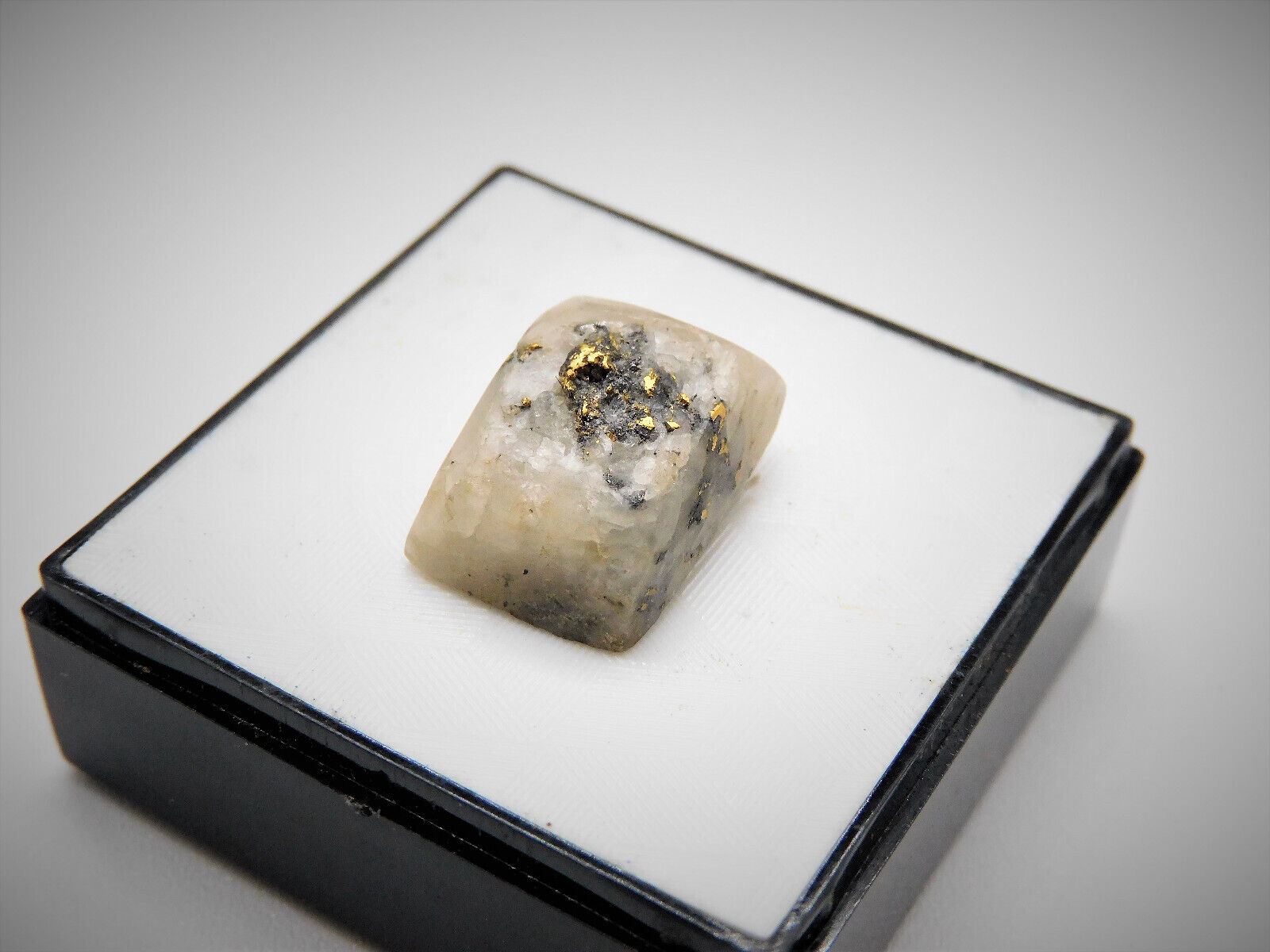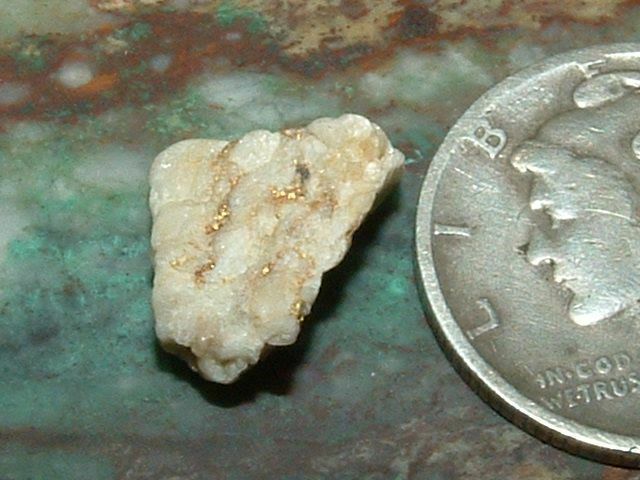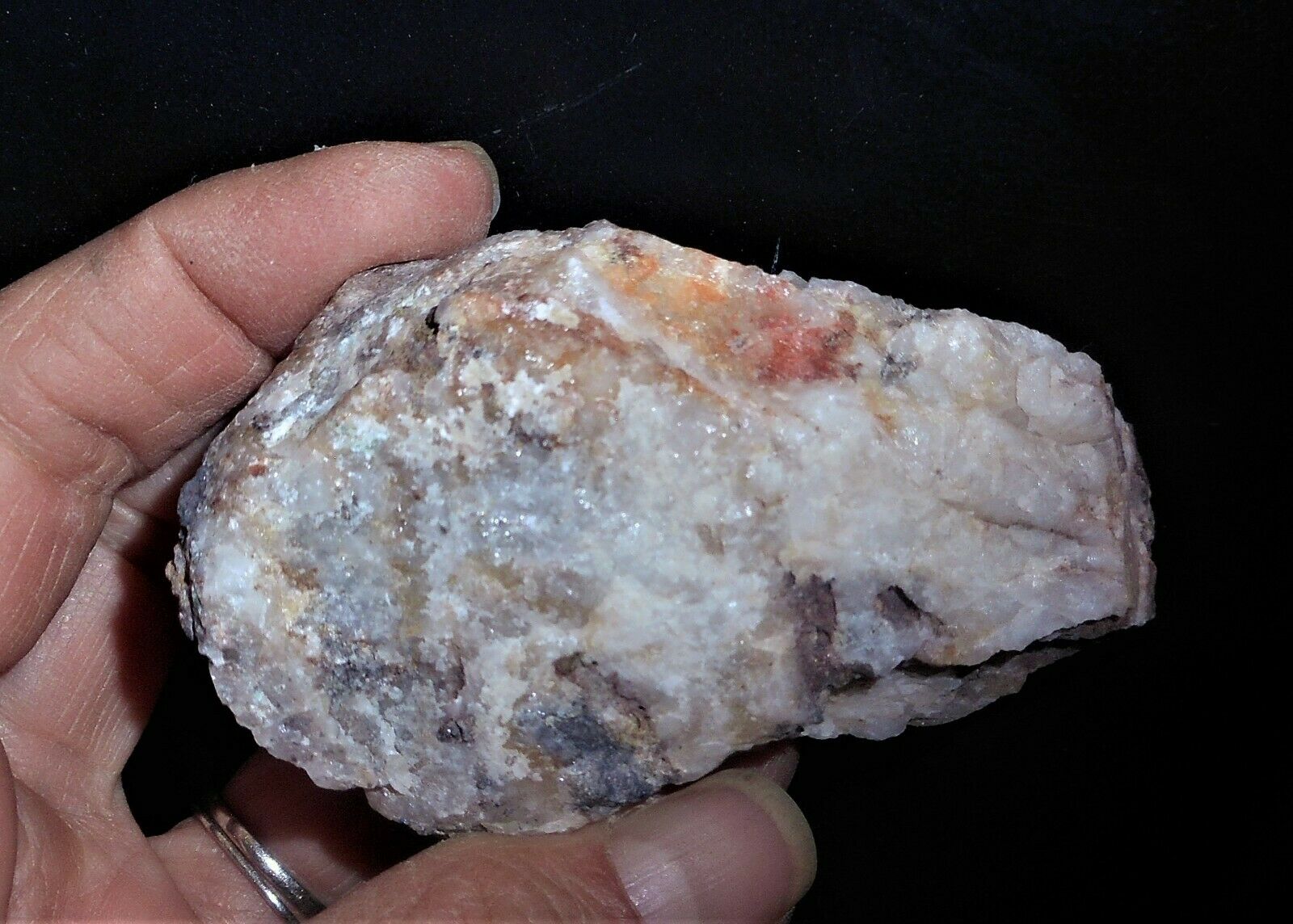-40%
CALIFORNIA GOLD QUARTZ SPECIMEN NATURAL GOLD 1.1 GRAM GOLD BEARING QUARTZ
$ 19.53
- Description
- Size Guide
Description
NATIVE GOLD QUARTZ SPECIMENfrom the
MOTHER LODE
R
uler is
1/4"
wide (6 mm). U.S. 10 cent coin is 17 mm in diameter.
S
pecimen weight:
1.1
G
ram -
16.9
G
rains (Troy)
S
ize:
11.1X9.6X8
mm long
If you like gold straight from the earth, check out this colorful chunk.
As found in nature, silicate rock is usually part of the gold specimen equation. As you can see, that's what we have here.
It has a beautiful row of gold crystals bubbling up in a row near the center of the quartz. This specimen shows a thick, rusty patina coating about half of the rock. Although it's a lousy investment for bullion hunters, there's eye-popping, microscopic beauty awaiting whoever might wish to examine this one up close. One can only begin to imagine how the 49ers reacted the first time they saw gold in their pans and sluices. Even more exciting, how about being the first to see a quartz vein loaded with the real Mccoy. That's an extremely rare occurrence even for died-in-the-wool' hard rock miners. The authenticity of this California gold & quartz specimen is guaranteed.
It takes a lot of effort to find gold whether it's placer, pocket, or high-grade lode. From my perspective, having spent so many years on the hunt for wild gold, there's really no such thing as an 'ugly nugget' or specimen. Each one is beautiful in it's own way. I guarantee the gold growths here are a natural occurrence.
All my specimens show visible gold and are
authentic
gold quartz specimens.
I don't paste 'pounded gold' or spray gold-colored paint on barren rock. Refractory ores, which need to be heated and run through special processes to release the minute amount of gold locked up inside, aren't usually my thing. When I do sell sulphides, you'll be able to see gold associated with the pyrites. You won't need to crush and treat my rocks with cyanide solution to dissolve the gold thereby allowing it's recovery. We're not dealing in micron oro. I deal in genuine high-grade, naturally-occurring gold quartz with visible gold, both as specimen and as jewelry-grade slab. Such rich rocks and lapidary rough are hard to find and expensive to obtain.
U.S. SHIPPING - .00
(includes USPS tracking to all U.S. destinations)
INTERNATIONAL CUSTOMERS - S&H .50
FAST REFUND OFFERED
(If, for any reason, you're not happy with this item)
I poured through old mining dumps for years looking at orange-yellow-rusty rock through a loupe, but I never found a piece with visible gold.
Hydrothermal solutions carrying gold and silica crystallized into veins of gold quartz. This specimen comes from one of the many vein systems sourcing the immense placer deposits of the Sierra Nevada Mtns, the famed Mother Lode.
Weight Conversions:
15.43 GRAINS = 1 GRAM
31.103 GRAMS = 1 TROY OUNCE
24 GRAINS = 1 PENNYWEIGHT (DWT)
20 DWT = 1 TROY OUNCE
480 GRAINS = 1 TROY OUNCE
S & H
Discounted for combined shipments.
U.S. BUYERS
S & H .00 (with USPS tracking to all U.S. destinations)
ATTN: INTERNATIONAL BIDDERS
INTNL. BUYERS - .50 via USPS 1ST Class mail.
On higher valued items, shipping via USPS Priority Mail International or Express is recommended.
See USPS International shipping calculations.
PAYMENTS
For U.S. buyers: We accept paypal
For intnl. customers: We accept paypal.
Pay securely with
www.paypal
.
Payment must be made within 7 days from close of auction. We ship as soon as funds clear. If you have questions, please ask them before bidding.
REFUNDS
We leave no stones un-turned insuring our customers get what they bargained for.
If you're not satisfied with this item, contact me. Then, if the problem can't be fixed, return product within 30 days in 'as purchased' condition for a full refund
PROSPECTING IN TRINITY COUNTY
Back in the 1980s, shortly after gold had risen to 00 per ounce and began it's descent, Trinity County still crawled with prospectors hoping it would climb back up. I worked the Shasta-Trinity Alps for four seasons, had a blast, and lived to tell my tale. That was one of the most exciting, adventurous periods of my life. Initially, the prospect of dredging on the bottom of some big river with 30 feet of water over your head didn't seem all that inviting. Once the early jitters had been shaken off, however, the thrill of working so deep became intoxicating. I'm certain the clearness of the water had something to do with that emotion. Pity the poor South American, Philipino, or African dredger forced to work long periods in some muddy abyss with just an air-hose clamped between your teeth.
Maybe it was the thought of those two, three, and four ounce cleanups which awaited. Maybe it was the schools of fish who enjoyed miners in their midst stirring up food from the bottom. Later on, I decided to build some gold-sucking contraptions myself. Wishing to learn the ropes, I wound up working on a few different crews before building a succession of five, six, and eight inch dredges. Any half-serious gold miner is eventually going to want equipment he can call his own. When not dredging, I reverted to more-traditional, small scale, hand-mining methods like sluicing, panning, high-banking, detecting, and dry-washing. A small dip box proved a most effective tool for testing bank run gravels and, of course, no prospector ventures anywhere without his gold pan. Detectors, as well, could be worth their weight in gold. Dredge owners and operators, running all manner of suction dredges, had staked up about 20 miles of river. Everyone joined the search for a rich pay-streak. Mining encampments proliferated. Out on a prospecting jaunt, it wasn't uncommon to stumble on a makeshift hootch anywhere out in the woods. Many of the old hydraulic cuts were inhabited by diggers trying to survive cheaply scraping out a little beer and tobacco money from the worked-over ground. This was a social dynamic not unlike that which existed a hundred years earlier. Judging from the TV reality shows, one might think this segment of the mining community was comprised mostly of misfits, guys on the lam, sociopaths, and growers, but back then was a different era and culture than it is today. Out in the bush, off the grid, there was a lot less hostility to be found back in the 1980s. Local 'woodsies' like myself were mostly honest, amiable fellows; guys down-on-their-luck preferring to live within their means up in the hills away from society's high cost of living and condescending attitudes.
Thanks for checking out our digs.
G
old of
E
ldorado
1-14-13







